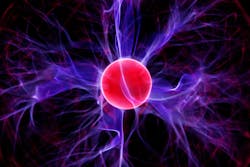Artificially intelligent software has been developed to enhance medical treatments that use jets of electrified gas known as plasma. The computer code predicts the chemicals emitted by plasma devices, which can be used to treat cancer, promote healthy tissue growth and sterilize surfaces.
The researchers involved in the project published a paper about their code in the Journal of Physics D: Applied Physics.
The plasma studied in the experiments is known as cold atmospheric plasma (CAP). When the CAP jet is turned on, numerous chemical species in the plasma take part in thousands of reactions. These chemicals modify the cells undergoing treatment in different ways, depending on the chemical composition of the jet. While scientists know that CAPs can be used to kill cancer cells, treat wounds and kill bacteria on food, it’s not fully understood why.
The project was completed by the Princeton Collaborative Low Temperature Plasma Research Facility (PCRF), a collaboration between researchers at the U.S. Department of Energy’s Princeton Plasma Physics Laboratory (PPPL) and the George Washington University (GWU).
The software uses an approach known as a physics-informed neural network (PINN). In a PINN, data is organized into parts called nodes and neurons. The flow of the data mimics the way information is processed in the human brain. Laws of physics are also added to the code.
Li Lin, a research scientist from GWU and the paper’s primary author, said it’s also difficult to calculate the chemicals in a CAP jet because the interactions need to be considered a nanosecond at a time. “When you consider that the device is in operation for several minutes, the number of calculations makes the problem more than simply computationally intensive. It’s practically impossible,” Lin said. “Machine learning allows you to bypass the complicated part.”
The project began with a small set of real-world data that was gathered using a technique known as Fourier-transform infrared absorption spectroscopy. The researchers used that small dataset to create a broader set of data. That data was then used to train the neural network using an evolutionary algorithm, which is a type of computer code inspired by nature that searches for the best answers using a survival-of-the-fittest approach. Several successive batches of data are generated using slightly different approaches, and only the best datasets from each round are carried through to the next round of training until the desired results are achieved.
Ultimately, the team was able to accurately calculate the chemical concentrations, gas temperature, electron temperature and electron concentration of the cold atmospheric plasma jet based on data gathered during real-world experiments. In a cold atmospheric plasma, the electrons — small, negatively charged particles — can be very hot, though the other particles are close to room temperature. The electrons can be at a low enough concentration that the plasma doesn’t feel hot or burn the skin while still being able to have a significant effect on the targeted cells.





